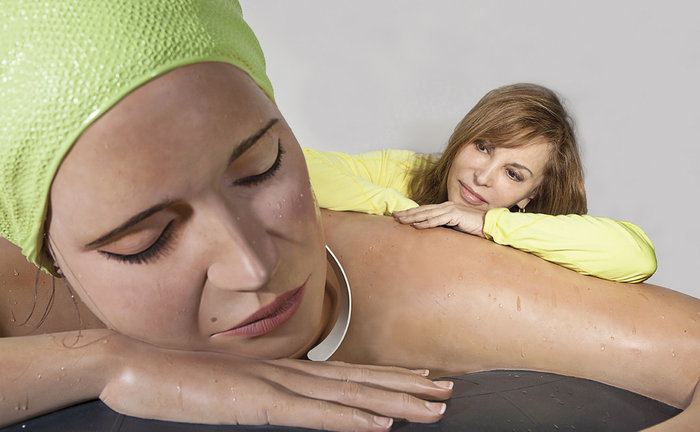When you enter Carole Feuerman’s gallery at Mana Contemporary, where she’s an artist-in- residence, you’ll spot an attractive, bearded man seated at a long reception desk. You’ll be struck by the way he looks straight at you. In his open-collared white shirt and blue jeans, thighs a bit parted, he appears relaxed and engaged. There’s a little depression in the center of his collarbone, and the knuckles on his hands gently grip the armrests. You’re staring at a sculpture, an astounding, impeccable imitation of life.
Though Feuerman paints, draws, does graphics, and video, she is recognized as one of the world’s finest and most prolific hyperrealist sculptors. “The word hyperrealism comes from photorealism,” she says. “That is, making a painting so real that it looks like a photo. Hyperrealism is a word used to describe a sculpture made to look so real that you might mistake it for a real, living person, complete with freckles, sun spots, eye lashes, and my signature water drops. I take the hyperrealism to the next level by making all clothing and accessories. They look like fabric and other materials but they are sculpted and painted to look real.”
Over the last four decades, Feuerman has created a range of resin, marble, and bronze works, from miniature to a height of 30 feet. Her art is in the collections of the Clintons, Mikhail Gorbachev, the Emperor of Japan, and Forbes Magazine, among others. The Grounds for Sculpture in Hamilton, N.J.; the El Paso Museum of Art; and the Boca Raton Museum of Art also house her work. Feuerman lectures at the Metropolitan Museum of Art, Columbia University, and the Guggenheim Museum.
She originally used the Mana space for storage until the warehouse converted to a contemporary art center with art studios, dance studios, viewing room, state-of-the-art climate-controlled storage room, art store, frame shop, and restaurant. But only a fraction of her art is at Mana. Her main gallery is Jim Kempner Fine Art in Manhattan. She also has a foundation, which encourages worthy artists, funds grants, and promotes her own work.
Feuerman, a bubbly, petite woman—she’s just five feet—grew up in Hollis Hills, Queens. She moved to Great Neck, Long Island, when she was 14. “I started doing art at 3 years old when my parents left me with a babysitter and I did my first painting with shoe polish,” she says. “I continued to draw using the Jon Gnagy method; I even liked ‘paint by numbers.’”
Feuerman’s desire to be an artist did not sit well with her mother, a housewife, and her father, who owned a taxi business. They refused to pay for art school when she quit Temple University to go to the School of Visual Arts in New York City.
She was able to take on freelance work that even the most seasoned artists would have jumped at. “My friend’s father ran the record division of Time Warner,” she relates. “I worked for him doing album covers. I did covers for very famous groups like Alice Cooper, The Rolling Stones, and Elton John. I got a scholarship at Visual Arts. The difference in tuition was paid for by my friend’s dad.”
Feuerman still lives in New York City, with her husband and children.
Feuerman is known for her sculptures of swimmers and bathers, which are in galleries, museums, and collections around the world. Mana has a few of these pieces. “Seventy percent of our body is made of water, so I feel it is another element that links the public to art,” she says. The eyes on her bathers are generally closed because, she says, “something about looking at the sculpture is disconcerting when it looks back at you. It makes the sculpture look more serene when the eyes are closed.” Feuerman’s “Diamond Dust Prints,” an array of large, glittering photographs of a bathing-capped swimmer, is in the Mana exhibit. Also at Mana is “The Gardener of Carolwood,” a hunched-over Frenchman who tended vineyards in Provence, France.
Feuerman paints “skin” onto the sculptured bodies. “When I sculpt oversized ones, I do smooth because most of the work is not cast from life,” she says. “It’s sculpted out of plaster and then molded in bronze or resin to look lifelike and be painted. The painted skin is as perfect as I can paint it on everything I make, both small and large.”
Creating sculptures can take from months to years. “The quickest takes six months, the longest, 10 years,” Feuerman says. “The concept is in my mind and I see the finish before I start. I work within a theme which tells a story. At first, it might just look like a girl resting on a tube on a sunny day, but it could be that she was surviving from something. I did my piece, ‘Survival of Serena,’ to represent the Island of Venice when it was called Serenissima. I wanted to make sure to commemorate the survival of Venice at the Venice Biennale. … The public cannot relate to that, but the swimmer is relatable to viewers.”
Feuerman’s prints start at $3,000. Her least expensive sculpture goes for $8,000. Her bronze “Serena” has a price tag of $100,000. Her “Diver” sells for $500,000, and double that for her “Double Diver.” Feuerman is working on variants of her “Diver” in her Mana studio to be shown at the 2013 Venice Biennale, right outside the entrance to the Biennale on the Island of Giardini.
Feuerman thinks of all of her work as interactive, so that it can connect with viewers. In one interactive video, the movement of a person’s hand or foot makes the image of the water move.
But no matter what Feuerman creates, she says, “It is classical beauty I am looking for.” —JCM
Mana Contemporary
888 Newark Ave.
(201) 604-2702
manafinearts.com
Jim Kempner Fine Art
501 West 23rd St.
NYC
(212) 206-6872
